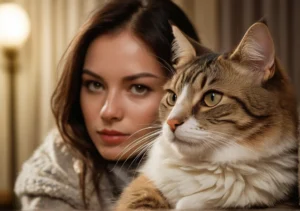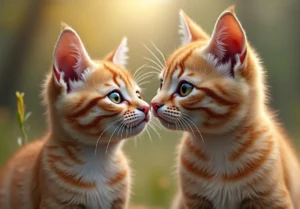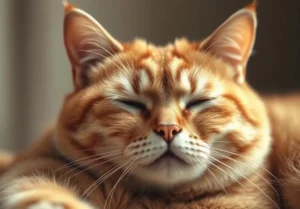Cats are notorious for their bursts of energy at night, often leaving their owners puzzled by their nocturnal antics. But why exactly are cats more energetic at night?
Cats’ natural instincts and biological makeup contribute to their heightened activity levels during the nighttime hours. Let’s explore the reasons behind this common feline behavior.
Evolutionary Factors
Cats’ preference for nighttime activity can be traced back to their ancestors who were nocturnal hunters. In the wild, cats relied on the cover of darkness to stalk and hunt their prey, making nighttime the ideal time for them to be alert and active. This instinctual behavior has been ingrained in domestic cats, explaining why they often exhibit more energy and playfulness during the night.
Circadian Rhythms
Cats’ internal clocks are wired differently from humans, leading to peak energy levels when the sun goes down. Unlike humans who are diurnal, cats are crepuscular animals, meaning they are most active during twilight hours. This natural rhythm is governed by their biology, with heightened senses and a burst of energy kicking in as night falls. This difference in circadian rhythms is why your cat may seem more lively and eager to play just as you’re winding down for the day.
- Stay in Sync with Nature: Encourage your cat’s natural instincts by providing interactive toys and play sessions in the evening to channel their energy in a positive way. Bonding through play also strengthens your relationship with your feline friend.
- Create a Nighttime Routine: Help your cat wind down by establishing a calming bedtime routine that includes quiet playtime, grooming, and a cozy sleeping area. Consistency in routine can signal to your cat that it’s time to rest, promoting better sleep habits for both of you.
By understanding the evolutionary factors and circadian rhythms that influence your cat’s nighttime energy levels, you can develop strategies to ensure a harmonious coexistence during those lively nighttime hours.
Temperature Regulation
Cats are more comfortable in cooler temperatures, which are often present during the nighttime, prompting increased activity. Their bodies are designed to function better in slightly lower temperatures, allowing them to expend more energy and be more playful when it’s cooler. So, when you see your cat racing around the house at night, it’s their way of staying cool and comfortable.
Hunting Behavior
Cats are hardwired to hunt and play in the dark, making nighttime the ideal time for them to hone their skills. Their natural instincts drive them to be more active when it’s dark outside, as this is when their prey is typically most active. So, when your cat is zooming around the house late at night, they are simply following their instinctual urge to stalk, pounce, and play. Just like their wild ancestors, domestic cats still have that inner hunter that comes alive in the quiet darkness.
Additional Insight:
It’s essential to provide your cat with opportunities to engage in hunting-like activities, even indoors. Interactive toys that stimulate their natural instincts to chase, pounce, and bat at moving objects can help satisfy their hunting cravings and keep them mentally and physically stimulated. This not only promotes a healthier, happier cat but also helps reduce nighttime restlessness and hyperactivity.
Solitude and Serenity
Cats are nocturnal creatures, meaning they are naturally more active during the night. The quiet and stillness of the nighttime environment offer cats a sense of peace and solitude, making them feel more comfortable and secure to unleash their playful side. This is when their energy levels peak, and they are more likely to engage in activities like chasing imaginary prey, running around the house, or climbing on furniture. Providing a safe and enriching environment for your cat during these nighttime bursts can help them fulfill their natural instinctual behavior and release pent-up energy.
Playtime and Bonding
Engaging with your cat during their nighttime energy bursts is crucial for fostering a stronger bond and providing essential mental stimulation. Interactive play sessions not only help your cat release excess energy but also strengthen the bond between you two. It is an excellent opportunity to connect with your feline friend on a deeper level and provide them with the attention and companionship they crave. Make sure to offer a variety of toys that cater to your cat’s hunting instincts, such as feather wands or laser pointers, to keep them entertained and engaged. Spending quality time with your cat during their nighttime activities can lead to a happier and healthier relationship between you and your furry companion.
Additional Unique Insight:
- Create a Kitty Play Zone: Designate a specific area in your home as a play zone for your cat during the night. Fill it with interactive toys, scratching posts, and cozy hiding spots to encourage your cat to engage in playful activities. This designated play area can help contain your cat’s energy and prevent them from getting into mischief around the house.
Tips for Managing Nighttime Energy
Does your cat’s nighttime zoomies keep you up at night? Try engaging your feline friend in interactive play sessions during the day to help them burn off excess energy. Incorporating puzzle feeders or treat-dispensing toys can also provide mental stimulation. Additionally, establish a nighttime routine that includes quiet activities to help signal to your cat that it’s time to wind down. Consider providing a comfortable sleeping spot away from your bedroom to prevent nighttime disruptions. If your cat’s energy levels persist, consult with a veterinarian to rule out any underlying health issues.
Fun Facts About Nocturnal Cats
Ever noticed how your cat’s eyes seem to glow in the dark? This is due to a special layer of cells, called the tapetum lucidum, located behind their retinas that helps them see better in low light conditions. Cats’ whiskers are not only cute but also serve as a vital sensory tool, helping them navigate and detect objects in the dark. Unlike humans, cats have a higher concentration of rod cells in their eyes, making them excellent night hunters. Another interesting tidbit is that cats are crepuscular, meaning they are most active during twilight hours, which explains their tendency to be more energetic at dawn and dusk. Embrace your cat’s nocturnal nature by providing them with ample opportunities for play and exploration during these times.
By incorporating these tips and understanding these fun facts, you can foster a harmonious relationship with your cat, both during the day and night. Embrace their unique behaviors and cater to their needs to ensure a happy and healthy feline companion.
Alex, a passionate animal lover, has experience in training and understanding animal behavior. As a proud pet parent to two dogs and three cats, he founded AnimalReport.net to share insights from animal experts and expand his knowledge of the animal kingdom.




